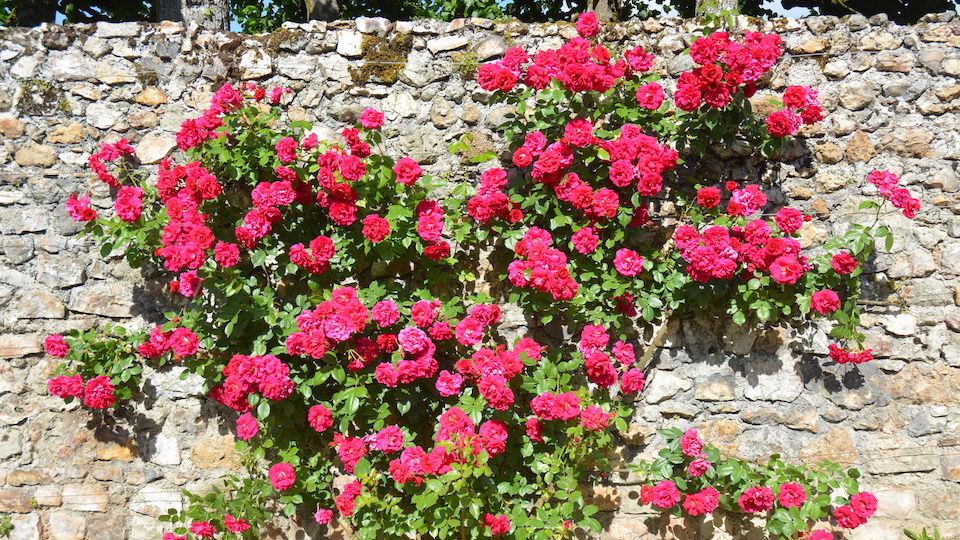There’s just something about climbing roses that makes me think of idyllic English gardens and fairytale cottages. If you love the look but have been hesitant to take the plunge into rose gardening, let me tell you…it’s not as hard as you think. This simple guide will give you everything you need to know about growing climbing roses and will set you on the path to success.
Select the right variety
When it comes to roses, your best bet is to speak with an expert when trying to find the perfect variety for your garden. Obviously, you will want a climbing rose such as Fourth of July, May Queen, New Dawn, or Dublin Bay, to name just a few. Each of these four varieties alone has different colors, growing patterns, sunlight needs, and pruning guidelines. Instead of getting overwhelmed in the nursery trying to decide, speak to someone who has planted climbing roses in your area before or is trained on the particular needs of each variety.
Ensure proper requirements
Roses love at least 4-6 hours of full sun each day and fertile-well draining soil. If your soil is lacking in nutrients, you may need to amend it with some organic matter or compost.
Know how and when to plant
Roses are usually sold as bare-root plants to be planted in late winter or early spring as soon as the ground can be worked. Whether you are buying them online or straight from a nursery, your roses won’t look like much at first but will quickly put down roots and flourish if given proper care.
Provide support
Naturally, a climbing rose will need something to climb on. Place it near a fence, arbor, trellis, or wall and center the plant under the support so that it is leaning slightly towards the object you want it to climb on. Remember, unlike vines, roses do not have tendrils that will wrap around a trellis and secure the canes. Once your plant starts growing, hand tie the canes to the trellis with stretchable material so that they will grow in the proper direction and won’t experience damage.
Remember, training horizontally rather than vertically will help you to get more blooms out of your climbing rose. Of course, there’s nothing wrong with training vertically, but the higher the canes, the fewer blooms, as each one produces just a single bloom at the end. Encourage new canes to grow through proper pruning and training.
Pruning
Avoid pruning for the first two years, at least (other than dead or diseased branches), as this will allow the plant to get established. Once it has matured slightly, you can prune the lateral canes lightly in autumn (after flowering) to help retain your desired shape and keep your rose looking tidy and under control. Remember, you should never prune the main canes that come from the base as these are where the rose directs most of its growing energy. Pruning these means that it will have to focus on growing these back and won’t flower as readily. Be careful not to over prune! Sprawling, natural climbing roses are often more appealing than tightly controlled, manicured ones. Go with the flow and thin out any twisted or awkward branches, but keep the majority of the rose intact.
As you prune, keep in mind that cutting just above a bud will encourage a new stem to grow. Only trim where you want to encourage growth.
Continuing care
Water roses consistently so that the soil stays moist but not soaking wet, as roses can develop fungus if their roots are kept wet. People often shy away from roses because they are seen as easily susceptible to several fungal problems, including black spot, anthracnose, powdery mildew, and rust. However, most of these can be avoided by planting in a sunny spot, watering properly, and pruning as needed. If you do notice any fungus on the leaves, remove the affected parts of the plant and dispose of them somewhere other than your compost pile. They may also attract pests such as aphids, scale, whiteflies, and rose curculio weevil, but these bugs can be eradicated with insecticidal soap or by simply spraying them off of the plant (for the larger bugs like aphids).
Suckers may appear at the base of the climbing rose. If so, pull them off immediately to avoid having them take over your plant.
Fertilize regularly with a well-balanced fertilizer. There are many types of fertilizer specifically designed for roses, so it should be easy to find the kind you need. Follow package instructions and fertilize according to the recommended schedule.
-Taylor Ramsey




